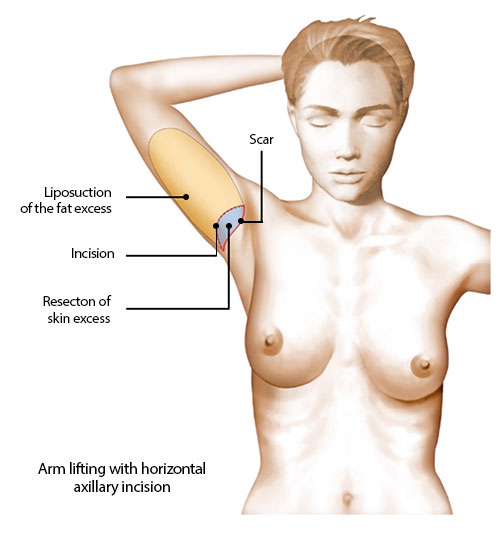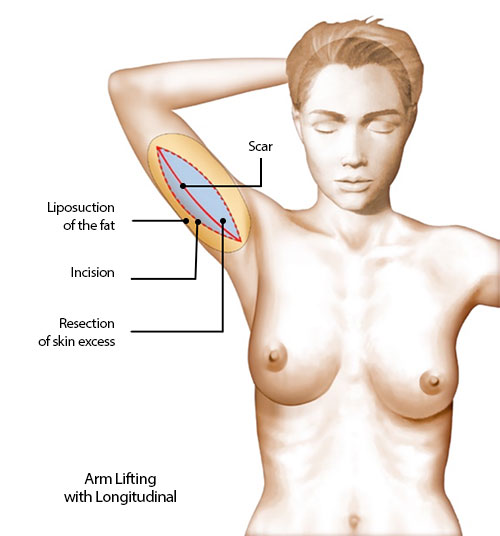DEFINITION, AIMS AND PRINCIPLES
The movement as well as the iterative lose of weight are “demanding” a lot to the skin of the inner part of the arm. It’s why the number of skin ptosis (not amenable to an isolated aspiration) is higher than the simple fat hypertrophies.
When skin distension takes place at this level, a lipoaspiration alone can’t be sufficient and just a skin tightening can improve this deficiency. This is what we call the arm lifting or the arm inner part lifting.
The aim of the surgery is to take away the excess of skin, to decrease the underneath fat infiltration and to redistribute the skin.
These lesions do not justify an assumption by health insurance, with the exception of sequelae of obesity (bariatric surgery) that may, under certain conditions, be reimbursed by health insurance.
BEFORE THE OPERATION
A meticulous clinical examination will determine the more appropriate type of surgical procedure you need (choice of incision, associated lipoaspiration indicated or not).
At the time of the first consultation, a precise information on the different surgical steps, on the follow-up and the expected results will be given to you. Specially, the location of the scar will be well explained.
An usual pre-operative evaluation is done, following the prescriptions.
An anesthesiologist must be seen in consultation, at least 48 hours before surgery, in case of general anaesthetic or “vigil” one.
Stopping smoking is strongly recommended at least one month before and one month after the intervention (smoking can cause a delayed healing).
No medicine with aspirin in it must be taken for at least 10 days before surgery.
Depending on the type of anesthesia, it can be asked to you to keep fasting (no food, no beverage) for 6 hours before surgery.
HOSPITAL STAY AND TYPE OF ANESTHESIA
Type of anesthesia: The inner arm lifting can be done under general anaesthesia, under local anaesthesia completed by tranquillizing drugs, injected in veins (“vigil” anaesthetic) or also, in some cases, under simple local anaesthesia.
The choice between these different techniques must come after you have discussed it with the surgeon and the anaesthesiologist.
Hospital stay: The surgery can be done in the “day care” department; it means, you can leave hospital the same day of the surgery, just after a few hours of resting and medical supervision.
On the other hand, you may be asked to stay in hospital over the night; it means, you enter the hospital early morning, the day of surgery (or sometimes the day before in the afternoon) and leave it the day after surgery.
THE PROCEDURE
Each surgeon is using his own technique, he may adapt to each case, in order to get the best result. Different techniques have been described.
The fat infitrated the skin is removed by lipoaspiration. The skin excess is removed and leaves a scar which location and length depend on the amount the skin laxity and on the procedure choosen.
The skin incision can be vertical, longitudinal, along the arm inner side or horizontal, following the armpit fold. Sometimes, the two types of incisions can be combined.
Arm lifting with longitudinal incision along the arm inner side
This surgical procedure responds, mainly, to patients having a major skin laxity with a high and clearly expressed motivation: beside the aesthetical bothering (discomfort wearing short sleeves due to the crumpled-up aspect of the arm) we can also find functionnal discomfort (mobility or clothing discomfort as redness or maceration of the arm inner side).
At first, a lipoaspiration is done, each time fat is found infiltrating the arm region.
Then, the skin excess is taking away as necessary, with a longitudinal incision along the arm inner side. The amount and the topography of this skin excess are always located with its limits drawn in collaboration with the patient in a standing position.
The average time of the surgery is one hour and a half. It may vary, depending on the extent of improvement needed.
At the end of surgery, a compressive dressing is done.
This type of arm lifting technique corrects with efficiency the as unsightly as embarrassing skin and fat excess but leaving a scar at the inner side of the arm.

This scar often remains visible; it’s why a specially rigorous selection of the surgical indications and a perfect patient information and consent are needed.
Considering the disadvantages of this type of arm lifting, from a scar point of view, we try to propose, as often as possible, a less ambitious surgery but with more acceptable scar: as an arm lifting with an isolated armpit incision or a combined procedure with an armpit incision plus a short vertical one of less than 10 cm.
Arm lifting with horizontal armpit incision
This type of surgery is aimed at a patient with less skin excess and laxity, mainly located at the upper third of the arm.
From a single horizontal incision, hidden in an armpit fold, combined, if necessary, with a liposuction, we can take away the skin excess of the upper part of the arm inner side. The sutures inside the armpit allow the residual skin to redistribute upward.
The residual scar is usually not very visible but the morphological result is less dramatic that the one obtained with a vertical scar arm lifting.
The average time of surgery is one hour.
At the end of surgery, a compressive dressing is done.
Because this procedure is lighter than the previous one, we can do it, most of the time, as day care, under local anaesthesia or under “vigil” one.
Such a surgical procedure is certainly less ambitious than the previous one but the main interest of it is its simplicity and lightness, allowing to possibly redoing it, one or two times within a few years. The repetition of this procedure will allow, each time, to still improve the result (following the patient wishes) due to complementary skin resection and redraping without elongating the scar, which should stay inside the armpit.
Combined technique
This is a synthesis of both previous procedures, realizing a compromising either concerning the advantages or the disadvantages particulary from the scar point of view.
This technique combines an horizontal incision inside the armpit with a short vertical one of less than 10 cm, at the arm inner side.
AFTER OPERATION: POST – OPERATIVE EFFECTS
The hospital outing usually takes place the same day or the day after surgery.
During the early follow-up period, ecchymosis (bruises) and edema (swelling) can appear. They will decrease within 10 to 20 days after surgery.
The pains are normally less important, limited to a certain discomfort, well balanced by the usual pain-killers.
The healing period can be a little unpleasant due to the skin tension around the scar borders. So, during this period we must avoid any brusque stretching motion.
The necessity to stop working will depend on the type of the professionnal activity. A sedentary work, in most of the cases, can be done again quickly, within a few days after surgery.
A sport activity or working out can be done, progressively, again within 4 weeks after surgery.
The scar is often pink-red during the first 3 months following surgery; after then it usually decreases progressively during 1 to 2 years. This evolution depends on the patient own skin specificity.
During the first 3 months following surgery, the scar must be protected from the sun and UV beams, by using sun blocks.
THE RESULT
It will be appreciated within 6 to 12 months after surgery.
Most of the time, we can see a good correction of fat infiltration and skin laxity, that improves a lot the arm aspect. The functionnal improvement is also very clear, especially in case of longitudinal incision arm lifting.
The scars are usually visible, particulary the longitudinal one, along the arm inner side which is not hidden in a natural fold.
Thanks to the technical improvement and to the acquired experience, the results of this surgery are getting better.
The goal of this surgery is to make an improvement and not to achieve perfection. If your wishes are realistic, the result should give you great satisfaction.
It remains, nevertheless, that a delicate surgery and even a high rigorous technique never totally protects from a certain amount of imperfections or complications.
DISAPPOINTING RESULT
Most of the time, a well-indicated and a well-done inner arm lifting gives a real help to the patient with a satisfactory and expected result.
However, localized imperfections are not rare and can be seen, without speaking of complication:
• These imperfections could concern the scar. It can be too visible, stretched or sticked. In case of a too high tension on the sutures, the scar can get an unpleasant aspect (hyper- pigmentation, thickness, retraction, adherence or enlargement). We must know, the scars decrease with time but never disappear totally. Considering this, just remember that it is the surgeon who does the sutures and the patient, the scar.
So the scars always follow hazards of scarring process, with a risk of getting hypertrophic requiring a specific treatment.
• Concerning the results of the lipoaspiration, they may show either a insufficiency of correction, a slight residual asymetry or small irregularities of the skin.
These imperfections into the result usually can be treated by complementary beneficial surgery, so called “slight surgical touching up”, done under pure local or deepened local anaesthesia. But, no secondary surgery must be done before the 6th month post-operatively, where the result starts to stabilize.
POSSIBLE COMPLICATIONS
Even if it is done for aesthetical purpose, the inner arm lifting remains a true surgical procedure because it can induce the same risks as any surgery as little it is.
We must distinguish the complications from anaesthesia and the one from surgery.
• Concerning anaesthesia, it’s the anaesthesiologist, himself, who will inform the patient of specific risks. We must know, that the anaesthesia may induce inside the body unpredictables reactions, more or less easy to control : dealing with a competent anaesthesiologist, working in a real surgical environment, pushes down statistically the risks up to an almost insignificant level.
The today techniques offer the patient an optimal security, especially if the patient is in good health.
• Concerning surgery, by choosing a qualified competent plastic surgeon, well trained for this type of surgery, you limit as much as possible all the risks without totally eliminating them however.
Complications could always occur after an arm inner side lifting which remains one of the more delicate procedure in the field of aesthetic plastic surgery.
Among, the considering complications, we can quote:
• The general complications: the thrombo-embolic failures (phlebitis, pulmonary embolism) are quite rare but very fearful. Rigorous preventive care must low its incidence, like, wearing compressive stockings, early raising up or sometimes by using anticoagulant drugs.
• The local complications:
- The occurence of an haematomais quite rare but could need its evacuation to protect the quality of the aesthetic result.
- The ocurrence of an infection is furthered by the proximity of a natural fold (usual bacterial pool), we can prevent by a meticulous hygienic care during either the pre- and post-operative period, up to the time of a complete healing. If necessary, surgical drainage and antibiotics can be required. We must know, that infection can leave unaesthetical sequels.
- The occurence of persistant lymphatic flow may be seen. It can reach the point of an effusion (swolling), which can necessitate ponctions but in most of the time, will spontaneously disappear without sequels.
- Delayed healing can sometimes occur which will delay the post operative results.
- Skin necrosis can exceptionally be seen. It is usually limited and localized. To prevent these necrosis, the arm lifting must be well-indicated and the surgery welladapted and carefully done.
- Sensitivity troubles, especially along the inner side of the arm can be seen. Normal sensitivity, most of the time, reappears within 3 to 6 months after surgery.
CONCLUSION
All things considered, the risks must not be overestimated, but you must be conscious that an operation, even a minor one, always has some degree of unforeseenable unknown factors.
You can be assured that if you are operated on by a qualified Plastic Surgeon, he will have the experience and skill required to avoid these complications, or to treat them successfully if necessary.


